by Sheila Dunning | Aug 26, 2016
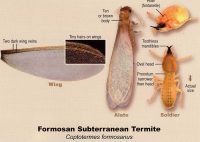 The genus Coptotermes contains the largest number of termite pests (28 species) worldwide, with the Formosan subterranean termite, Coptotermes formosansus, being the most widely distributed and most economically important. During the 1960’s it was found in Texas, Louisiana, and South Carolina. The first well-established colony in Florida was reported in 1980.
The genus Coptotermes contains the largest number of termite pests (28 species) worldwide, with the Formosan subterranean termite, Coptotermes formosansus, being the most widely distributed and most economically important. During the 1960’s it was found in Texas, Louisiana, and South Carolina. The first well-established colony in Florida was reported in 1980.
A single colony of Formosan subterranean termite may contain several million termites that forage up to 300 feet in soil. Once established, the Formosan subterranean termite has never been eradicated from an area. Therefore, monitoring of movement of the species is critical. Beginning in 2015, the Florida Department of Agriculture of Consumer Science (FDACS) began trapping the alates. Termites have three primary castes: the reproductive, soldiers, and workers. Within the reproductive caste, the young females, referred to as alates, are the ones that leave the colony. They are able to form wings and seek new areas to become established. Dispersal flights or “swarms” are massive and begin at dusk on calm and humid evenings from April to July. Alates are attracted to lights.
The objective of the FDACS Formosan Termite Alate project is to trap alates throughout the four most western counties of the Panhandle during their major swarm season in May and June, which is the time they are most active in that part of Florida. Trapped alates were counted on a weekly basis to determine peak swarming weeks. White, gridded 7”x 4” sticky card attached to 6’ stakes are placed under strong, predetermined street lights. Twenty-two trap locations were selected, each representing a key Panhandle community with at least one location North of I-10 within each of the four counties.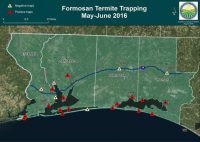
In 2016, sixteen out of the 22 traps were positive for Formosan termite alates throughout the four Panhandle counties. Formosan alates were caught during 7 of the 8 weeks of trapping. The largest spike in numbers trapped was during the week of May 8th. A subsequent swarming spike occurred during the week of May 22nd. Trap locations that were positive in 2016 and not 2015 included Pensacola Beach, Destin, Blue Mountain Beach, Okaloosa Island and Choctaw Beach. The project will be continued each year in order to determine some of the problem areas.
For more information go to:
by Sheila Dunning | Aug 26, 2016
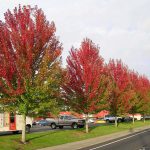 Red Maples are among the most frequently planted urban trees. Many of its features, especially its leaves are quite variable in form. Its flowers, petioles, twigs and seeds are all red to varying degrees. But, it is best known for its brilliant deep scarlet foliage in autumn. Red Maple is adaptable to a wide range of site conditions, perhaps more so than any other tree in eastern North America. It can be found growing in swamps, on poor dry soils, and most anywhere in between. However, the tree health and appearance decreases when trees have more impervious surfaces around them.
Red Maples are among the most frequently planted urban trees. Many of its features, especially its leaves are quite variable in form. Its flowers, petioles, twigs and seeds are all red to varying degrees. But, it is best known for its brilliant deep scarlet foliage in autumn. Red Maple is adaptable to a wide range of site conditions, perhaps more so than any other tree in eastern North America. It can be found growing in swamps, on poor dry soils, and most anywhere in between. However, the tree health and appearance decreases when trees have more impervious surfaces around them.
North Carolina State University research has developed the impervious surface threshold (http://content.ces.ncsu.edu/impervious-surface-threshold-for-sustainable-urban-tree-planting-and-landscaping-design) which can be used to identify planting sites where Red Maple will thrive. Landscape architects, urban planners, arborists, landscapers, and other professionals can use these impervious surface thresholds to reduce Red Maple management and replacement costs.
Trees surrounded by less than 33% impervious surface cover will most likely be in good or excellent condition. Trees surrounded by 33%-66% are likely to be in fair condition. Trees surrounded by 67% or more tend to be in poor condition. Impervious surface cover can be measured by using the “Pace to Plant” technique.
The “Pace to Plant” technique is a tool to quickly and accurately quantify the amount of impervious surface surrounding a tree or planting site. Begin by standing at the planting site and identify the closest impervious surface edge. Take 25 steps at 45⁰ to the nearest impervious edge, counting only the steps that land on the impervious surface. Then, return to the identified planting site and begin walking 25 steps in the opposite direction. Again, only count the steps that fall onto impervious surface. If you encounter a building or wall, count the remainder of the steps as impervious. One more time, return to the starting planting site. This time turn 90° and begin walking 25 steps and count the steps that fall onto impervious surface. Finally, turn around and go back to the planting site and begin walking in the opposite direction for 25 steps. This will be the fourth time that steps falling onto the impervious surface are counted. Having walked in four directions located 90° from each other, completing an “X” through the planting site, the transect is final with a total of 100 steps have been taken. By totaling the number of steps that fall onto impervious surfaces the percentage of the surrounding ground area can be determined. For example, if the total number of steps falling on impervious surface is 65 (out of the potentially 100 steps), the percentage of impervious surface is 65%. Using the established criteria, the site would not be suitable for planting a Red Maple.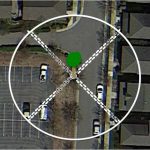
While North Carolina State has only researched the Red Maple tree species, the “Pace to Plant” technique could be used to determine suitable sites for many different trees being considered for commercial urban planting.
By evaluating the impervious surface restrictions, better tree species selection may be possible. If the right tree for the right place is chosen well, stress to urban trees, including pest infestations, can be reduced.
by Matt Lollar | Jun 27, 2016
Cattle aren’t really grazing on the trees (this time), but tree cattle (a.k.a. bark lice) are grazing on the trees. The scientific name for tree cattle is Cerastipsocus venosus. Adults have shiny black wings that are held at a sharp angle resembling an old style camping tent or an F-117 Nighthalk stealth fighter. Wingless adults also exist.
The nymphs have an ovate abdomen with dark gray and light yellow banding similar to a honeybee. A related species, Archipsocus nomas, is known to produce unharmful webbing that covers the trunk and branches of trees, but not the leaves.
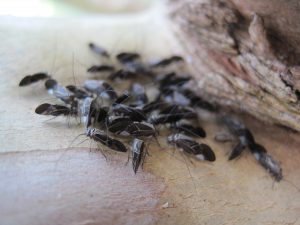
Tree cattle herd on a crape myrtle. Photo Credit: UF/IFAS Extension.
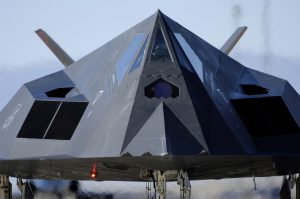
An F-117 Nighthawk. Photo Credit: Staff Sgt. Jason Colbert, U.S. Air Force.
These insects are usually seen in a colony containing a mixture of nymphs and adults. Unlike hair lice, bark lice are not parasites and are classified as beneficial insects. Unlike most beneficial insects, they do not feed on other insects. Instead, they clean the bark by eating excess accumulations of fungi, algae, lichens, dead bark, and other nonliving material. Tree cattle are not bark borers and do not eat leaves or living bark.
They are often seen on crape myrtles, but have been reported to graze on oaks and Bradford pears. Bark lice are more prevalent during hot and humid summer months.
Tree cattle are classified as beneficial, therefore no management is required. Because clientele may consider the term beneficial insect to be an oxymoron, it is important to supply supplemental educational materials to back up your claim. Publications are available from Clemson University and Auburn University.

by Blake Thaxton | May 24, 2016
Author: Dr. Mathews Paret
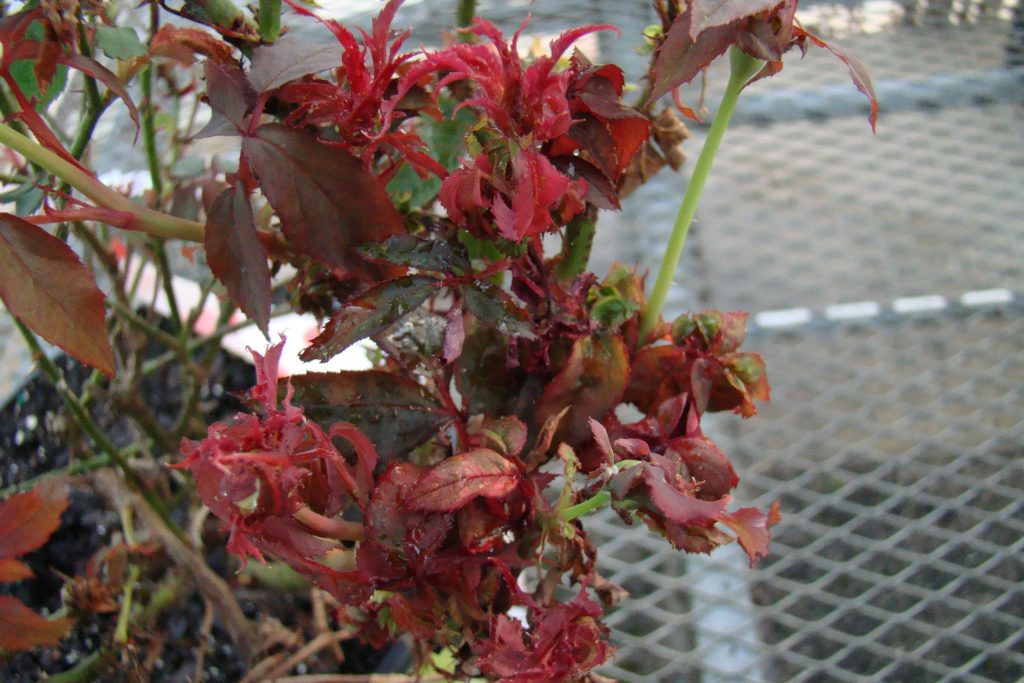
Rose Rosette (Photo Credits: Mathews Paret)
Caused by: Rose rosette virus (Currently not present in Florida; but previously discovered in three counties in Florida in 2013 and 2014 led to the successful destroyal of the infected plants)
Vectored by: An eriophyid mite species; Phyllocoptes fructiphilus (Not known to be present in Florida). Grafting or budding can also transmit the virus from infected to healthy plants
Why is monitoring for rose rosette disease in Florida important?
- Currently, Florida is the state with the largest value in wholesale production of roses in the U.S ($29.7 million)
- The landscaping industry in Florida heavily uses roses and especially shrub roses.
- The disease can affect all varieties of roses
- Currently, there is no known cure for Rose Rosette Disease, and hence early detection and eradication of infected plants is the key to prevent any establishment of the disease in Florida
Thus, monitor and report to the county extension agent or University of Florida, Plant Pathology Lab at NFREC, Quincy if suspicious plants are noted. This is critical in ensuring that Florida roses are well protected this year and in the coming years from Rose Rosette Disease.
Symptoms of the disease and details of the virus can be found in the following documents.
Rose Rosette Disease: A new disease of roses in Florida
http://edis.ifas.ufl.edu/pdffiles/PP/PP31700.pdf
IFAS Pest Alert: Rose Rosette Virus
http://programs.ifas.ufl.edu/u-scout/Alert_files/RRV_PestAlert_Paret_2014.pdf
Relevant information on all major diseases of roses in Florida can be also found at U-scout website of NFREC, University of Florida
http://programs.ifas.ufl.edu/u-scout/Rose/Rose.html
Contact person:
Mathews Paret
Assistant Professor, Plant Pathology
University of Florida, NFREC, University of Florida paret@ufl.edu, 850-875-7154
by Beth Bolles | Apr 22, 2016
Muhly grass (Muhlenbergia capillaris) is a generally pest free plant in our area, however, we are seeing the native mealybug, Stemmatomerinx acircula, on plants in various landscapes. Insects are on the leaves and are grey with white wax that may have some filaments. You may also see long ovisacs on the leaves which contain eggs and crawlers. The native fakahatchee grass may also be a host.
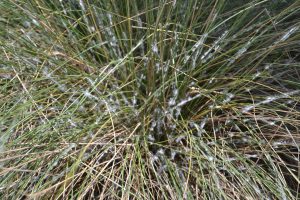
Muhly grass infested with mealybug. Photo: Beth Bolles
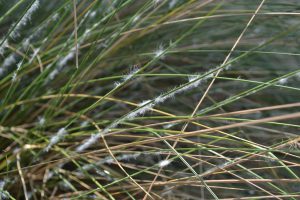
The mealybug is white with fine filaments and numerous mealybugs can be found each leaf. Photo: Beth Bolles
The common practice of right plant, right place does not always prevent the mealybug infestations on muhly grass. Specimens in both full and shade can be affected, as well as mass plantings and those spaced out. At this time, there is not a lot of information on why some plantings are heavily infested and others are not.
Since mealybugs are piercing sucking insects, there may be some browning of leaves, especially on less vigorous plants. You may have to remove and destroy plants that are heavily infested and declining. In situations where treatment is warranted you may choose a systemic insecticide or oil spray to keep plants looking more attractive. As the landscape manager, you will need to decide what is an acceptable threshold for this pest.
by Julie McConnell | Oct 27, 2015
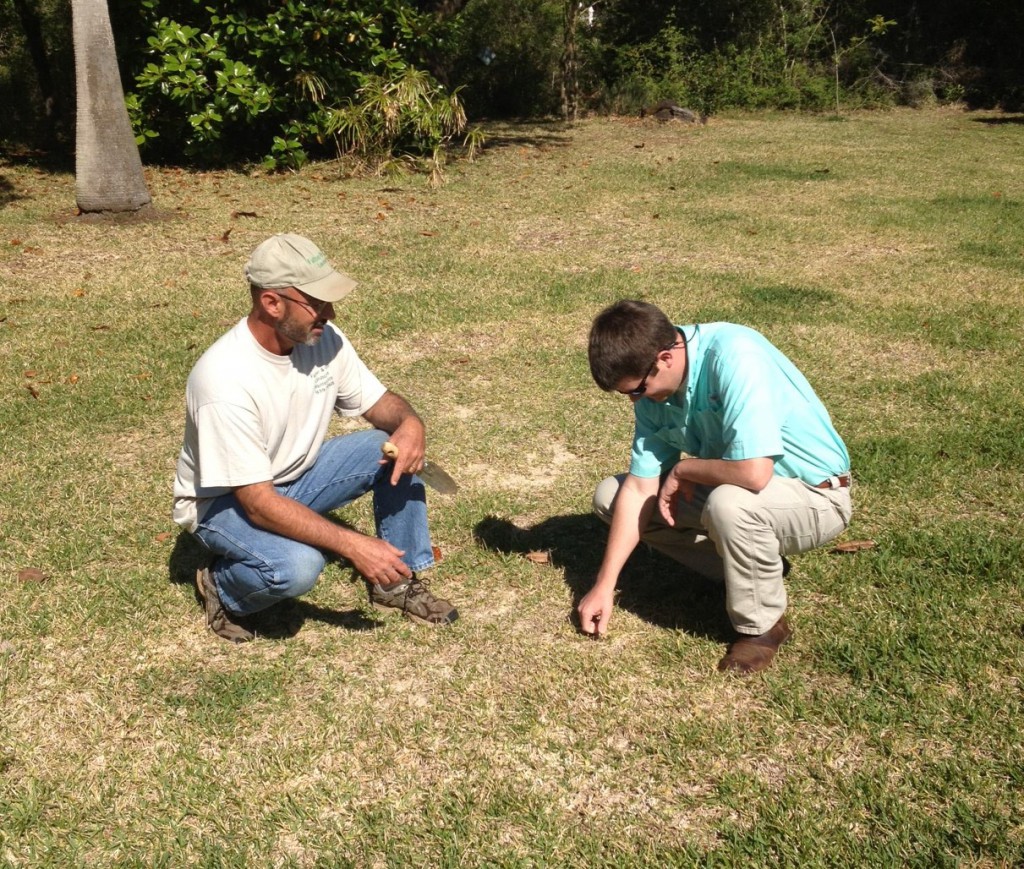
UF/IFAS Extension working with horticulture professionals scouting turf issues. Photo Credit: Blake Thaxton
Using an Integrated Pest Management (IPM) approach to landscape management has been an integral part of the green industry for many years. The strategies help to make pest control more efficient by incorporating multiple methods and being flexible enough to make changes where needed.
One of the most critical steps in your IPM plan is monitoring and correct pest identification. If the pest is not identified correctly, then any steps taken to control that pest will be ineffective and may also mask the original problem making it harder to get a correct diagnosis.
Correct identification does not stop at naming the pest in question. More research needs to be done to choose the appropriate management methods. Some key questions to answer are:
• What are the primary hosts in this landscape?
• How can we manage the landscape to make the pest less successful?
• What is the life cycle of the pest?
• How/where does it reproduce?
• At which stage of the life cycle are we likely to get the best control?
• Are there different strategies based on life cycle stage?
Answering these questions will help you choose appropriate control methods whether cultural, mechanical, biological, or chemical. Remember to always keep good records and modify your plan as needed.
For more information visit https://edis.ifas.ufl.edu/topic_pest_management
 The genus Coptotermes contains the largest number of termite pests (28 species) worldwide, with the Formosan subterranean termite, Coptotermes formosansus, being the most widely distributed and most economically important. During the 1960’s it was found in Texas, Louisiana, and South Carolina. The first well-established colony in Florida was reported in 1980.
The genus Coptotermes contains the largest number of termite pests (28 species) worldwide, with the Formosan subterranean termite, Coptotermes formosansus, being the most widely distributed and most economically important. During the 1960’s it was found in Texas, Louisiana, and South Carolina. The first well-established colony in Florida was reported in 1980.
 Red Maples are among the most frequently planted urban trees. Many of its features, especially its leaves are quite variable in form. Its flowers, petioles, twigs and seeds are all red to varying degrees. But, it is best known for its brilliant deep scarlet foliage in autumn. Red Maple is adaptable to a wide range of site conditions, perhaps more so than any other tree in eastern North America. It can be found growing in swamps, on poor dry soils, and most anywhere in between. However, the tree health and appearance decreases when trees have more impervious surfaces around them.
Red Maples are among the most frequently planted urban trees. Many of its features, especially its leaves are quite variable in form. Its flowers, petioles, twigs and seeds are all red to varying degrees. But, it is best known for its brilliant deep scarlet foliage in autumn. Red Maple is adaptable to a wide range of site conditions, perhaps more so than any other tree in eastern North America. It can be found growing in swamps, on poor dry soils, and most anywhere in between. However, the tree health and appearance decreases when trees have more impervious surfaces around them.



